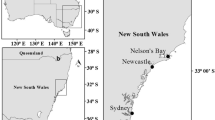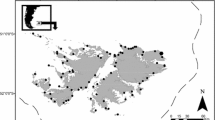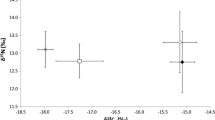Abstract
Feeding habits of many batoid elasmobranchs have been recorded, but diets, prey selection, and resource partitioning within specific populations are not fully understood. Few descriptions exist of the diet of a batoid species throughout its entire life history. Through gut content analysis, our research examined the feeding habits of the bullnose ray, Myliobatis freminvillii, to understand the diet and trophic role of this species in the Delaware Bay at various life stages. We were able to collect a higher abundance of neonate and juvenile rays than expected allowing for a more comprehensive diet characterization than in past studies. Over the course of 2 years, 160 specimens were collected through fisheries-independent trawl surveys, of which 132 had stomach contents. Overall, this species feeds mainly on hermit crabs and gastropods, with some bivalves as well. Diet was shown to vary across months and across life history stages. Diet data for the various months and life stages of this species in Delaware Bay can provide new information for future efforts in conservation, ecosystem-based fisheries management, and modeling.





Similar content being viewed by others
References
Ajemian M, Powers S (2011) Habitat-specific feeding by cownose rays (Rhinoptera bonasus) of the northern Gulf of Mexico. Environ Biol Fish 95:79–97
Amundsen PA, Glaber HM, Staldvik FJ (1996) A new approach to graphical analysis of feeding strategy from stomach contents data. Modification of the Costello (1990) method. J Fish Biol 48:607–614
Baum JK, Myers RA, Kehler DG, Worm B, Harley SJ, Doherty PA (2003) Collapse and conservation of shark populations in the Northwest Atlantic. Science 299:389–392
Bearden C (1959). A life history study of the eagle ray, Myliobatis freminvillii Lesueur 1824, in Delaware Bay. Masters Thesis, University of Delaware
Bigelow HB, Schroeder WC (1953) Sawfishes, guitarfishes, skates and rays. In: Tee-Van J, Breder CM, Hildebrand SF, Parr AE, Schroeder WC (eds) Fishes of the Western North Atlantic. Part 2. Yale Univ, New Haven, pp 1–514
Bizzarro JJ, Robinson HJ, Rinewalt CS, Ebert DA (2007) Comparative feeding ecology of four sympatric skate species off central California, USA. Environ Biol Fish 80:197–220
Bizzarro JJ, Smith WD, Márquez-Farías JF, Tyminski J, Hueter RE (2009) Temporal variation in the artisanal elasmobranch fishery of Sonora, Mexico. Fish Res 97:103–117
Bowman RE, Stillwell CE, Michaels WL, Grosslein MD (2000) Food of Northwest Atlantic fishes and two common species of squid. N. U.S. Department of Commerce. NOAA Tech Memo NMFS-NE-155. 137 pp
Brown SC, Bizzarro JJ, Cailliet GM, Ebert DA (2011) Breaking with tradition: redefining measures for diet description with a case study of the Aleutian skate Bathyraja aleutica (Gilbert 1896). Environ Biol Fish 95:3–20
Clarke KR, Warwick RM (2001) Change in marine communities: an approach to statistical analysis and interpretation, 2nd edn. PRIMER-E, Plymouth
Collins AB, Heupel MR, Hueter RE, Motta PJ (2007) Hard prey specialists or opportunistic generalists? An examination of the diet of the cownose ray Rhinoptera bonasus. Mar Freshw Res 58:135–144
Colwell RK (2013) EstimateS: statistical estimation of species richness and shared species from samples. Version 9.0. User’s guide and application published at: http://purl.oclc.org/estimates
Cortés E (1997) Critical review of methods of studying fish feeding based on analysis of stomach contents: application to elasmobranch fishes. Can J Fish Aquat Sci 54:726–738
Cortés E (1999) Standardized diet compositions and trophic levels in sharks. ICES J Mar Sci 56:707–717
Dulvy NK, Baum JK, Clarke S, Compagno LJV, Cortés E, Domingo A, Fordham S, Fowler S, Francis MP, Gibson C, Martínez J, Musik JA, Soldo A, Stevens JD, Valenti S (2008) You can swim but you can’t hide: the global status and conservation of oceanic pelagic sharks and rays. Aquat Conserv Mar Freshw Ecosyst 18:459–482
Ebert DA, Bizzarro JJ (2007) Standardized diet compositions and trophic levels of skates (Chondrichtyes: Rajiformes: Rajoidei). Environ Biol Fish 80:221–237
Ellis J, Dulvy NK, O’Brien C, Sims D, Southall E (2005a) FOREWORD: shark, skate and ray research at the MBA and Cefas. J Mar Biol Assoc UK 85:1021–1023
Ellis J, Dulvy NK, Jennings S, Parker-Humprheys M, Rogers SI (2005b) Assessing the status of demersal elasmobranchs in UK waters: a review. J Mar Biol Assoc UK 85:1025–1047
Farhenthold DA (2004) Oyster project consumed with problems. Washington Post, www.Washingtonpost.com/wp-dyn/articles/A29969-2004Aug24.html (25 Aug. 2004)
Ferry LA, Cailliet GM (1996) Sample size and data analysis: are we characterizing and comparing diet properly? In: MacKinlay D, Shearer K (eds) Feeding ecology and nutrition in fish, international congree of the biology of fishes. American Fisheries Society, San Francisco
Gosner KL (1971) Guide to identification of marine and estuarine invertebrates: Cape Hatteras to the bay of Fundy. John Wiley & Sons, Inc, New York
Gosner KL (1978) A field guide to the Atlantic seashore. NY. Houghton Mifflin Company, New York
Gray AE, Mulligan TJ, Hannah RW (1997) Food habits, occurrence, and population structure of the bat ray, Myliobatis californica, in Humboldt Bay, California. Environ Biol Fish 49:227–238
Hansson S (1998) Methods of studying fish feeding: a comment. Can J Fish Aquat Sci 55:2706–2707
Hyslop EJ (1980) Stomach contents analysis: a review of methods and their application. J Fish Biol 17:411–429
Karl S, Obrebski S (1976) The feeding biology of the bat ray, Myliobatis californica in Tomales Bay, California. In: Simenstad CA, Lipovski SJ (eds) Fish food habit studies. Washington Sea Grant, Seattle, pp 181–186
Koen Alonso M, Crespo EA, García NA, Pedraza SM, Marrioti PA, Berón Vera B, Mora NJ (2001) Food habits of Dipturus chilensis (Pisces: Rajidae) off Patagonia, Argentina. ICES J Mar Sci 58:288–297
Kraft JC (1988) Geology. In: Bryant TL, Pennock JR (eds) The Delaware estuary: rediscovering a forgotten resource. University of Delaware Sea Grant, Newark, pp 31–42
Matern SA, Cech JJ, Hopkins TE (2000) Diel movements of bat rays, Myliobatis californica, in Tomales Bay, California: evidence for behavioral thermoregulation? Environ Biol Fish 58(2):173–182
McCandless CT, Kohlher NE, Pratt HL Jr (2007) Species specific shark nursery habitat summary tables. In: McCandless CT, Kohlher NE, Pratt HL Jr (eds) Symposium 50 Shark nursery grounds of the Gulf of Mexico and the east coast waters of the United States. American Fishery Society, Bethesda, pp 365–390
McElroy WD (2009) Diet, feeding ecology, trophic relationships, morphometric condition, and ontongeny for the Sandbar Shark, Carcharhinus plumbeus, and Smooth Dogfish, Mustelus canis, within Delaware Bay Estuary. Dissertation, University of Rhode Island
McElroy WD, Wetherbee BM, Mostello CS, Lowe CG, Crow GL, Wass RC (2006) Food habits and ontogenetic changes in diet of the sandbar shark, Carcharhinus plumbeus, in Hawaii. Environ Biol Fish 76:81–92
Merriner JV, Smith JW (1979) A report to the oyster industry on the biology and management of the cownose ray (Rhinoptera bonasus, Mitchill) in lower Chesapeake Bay. Special report in applied marine science and ocean engineering. Virginia Institute ofMarine Science, Gloucester Point
Merson RR, Pratt HL Jr (2001) Distribution, movements, and growth of young sandbar sharks, Carcharhinus plumbeus, in nursery grounds of Delaware Bay. Environ Biol Fish 61:13–24
Michels SF, Greco MJ (2008) Coastal finfish assessment survey. Project: F-42-R-20. Delaware, Dept. Natural Resource and Environmental Control Apr. 1, 2007–Mar. 31, 2008
Michels SF, Greco MJ (2011) Coastal finfish assessment survey. Project: F-42-R-23. Delaware, Dept. Natural Resource and Environmental Control Apr. 1, 2010–Mar. 31, 2011
Myers RA, Baum JK, Shepherd TD, Powers SP, Peterson CH (2007) Cascading effects of the loss of apex predatory sharks from a coastal ocean. Science 315:1846–1850
Pauly D, Christensen V (1995) Primary production required to sustain global fisheries. Nature 374(6519):255–257
Pauly D, Christensen V, Dalsgaard J, Froese R, Torres F Jr (1998a) Fishing down marine food webs. Science 279:860–863
Pauly D, Trites AW, Capuli E, Christensen V (1998b) Diet composition and trophic levels of marine mammals. ICES J Mar Sci 55:467–481
Pennock JR, Sharp JH (1986) Phytoplankton production in the Delaware Estuary: temporal and spatial variability. Mar Ecol Prog Ser 34:143–155
Peterson C, Fodrie J, Summerson H, Powers S (2001) Site-specific and density-dependent extinction of prey by schooling rays: generation of a population sink in top-quality habitat for Bay scallops. Oecologia 129:349–356
Pinkas LM, Oliphant S, Iverson ILK (1971) Food habits of albacore, bluefin tuna and bonito in Californian waters. Calif Fish Game 152:451–463
Pollock LW (1998) A practical guide to the marine animals of Northeastern North America. Rutgers University Press, New Brunswick
Powers SP, Gaskill D, Peterson CH, Fodrie FJ (2011) Density dependent predation by migratory predators creates sink populations in a marine benthic landscape. Mar Ecol Prog Ser, in press
Rehder HA (1981) National Audobon Society field guide to North American seashells. Alfred A. Knopf, Inc, New York
Ridge RM (1963) Food habits of the bat ray, Myliobatis californica, from Tomales Bay, California. M.A. Thesis,University of California, Berkeley. 56 pp
Rountree RA, Able KW (1996) Seasonal abundance, growth, and foraging habits of juvenile smooth dogfish, Mustelus canis, in a New Jersey estuary. Fish Bull 94(3):522–534
Smith RI (1964) Keys to the marine invertebrates of the woods hole region. Marine Biological Laboratory, Woods Hole
Smith JW, Merriner JV (1985) Food habits and feeding behavior of the cownose ray, Rhinoptera bonasus, in lower Chesapeake Bay. Estuaries 8:305–310
Smith EP, Pontasch KW, Cairns J Jr (1990) Community similarity and the analysis of multispecies environmental data: a unified statistical approach. Water Res 24:507–514
Stevens JD, Bonfil R, Dulvy NK, Walker PA (2000) The effects of fishing on sharks, rays, and chimeras (chondricthyans), and the implications for marine ecosystems. J Mar Sci 57:476–494
Talent LG (1982) Food habits of the gray smoothhound, Mustelus californicus, the brown smoothhound, Mustelus henlei, the shovelnose guitarfish, Rhinobatos productus, and the bat ray, Myliobatis californica, in Elkhorn Slough, California. Calif Fish Game 68:224–234
Acknowledgments
Thanks go to Cliff Katz, Ted Durbin, Jeremy Collie, and Brad Seibel for their intellectual advice and statistical help. Sample collection was only possible with the help of the RI Department of Environmental Management and the DE Department of Natural Resource and Environmental Control; specifically, the crews of the R/V Chaffee (Scott Olszewski and crew) and the R/V First State (Stewart Michels and crew). Sample processing and cataloguing were greatly facilitated by Peter Schooling, Christina Lemnotis and Juliana DeLuca. I need to thank Joe Bizzarro for further advice on statistics and techniques and Matt Ajemian and Julie Neer for organizing the Stingray Biology Symposium of JMIH 2013. The Save Our Seas Foundation and the American Elasmobranch Society funded the presentation of research and publication of this manuscript whereas the URI Research Office, the URI Biology Department and the College of Environment and Life Sciences, the Graduate Student Associate and the Graduate Assistants United of URI all contributed to financial assistance for travel and presentation of this work. This research was conducted with the approval of URI’s Institutional Animal Care and Use Committee.
Author information
Authors and Affiliations
Corresponding author
Rights and permissions
About this article
Cite this article
Szczepanski, J.A., Bengtson, D.A. Quantitative food habits of the bullnose ray, Myliobatis freminvillii, in Delaware Bay. Environ Biol Fish 97, 981–997 (2014). https://doi.org/10.1007/s10641-014-0282-3
Received:
Accepted:
Published:
Issue Date:
DOI: https://doi.org/10.1007/s10641-014-0282-3




